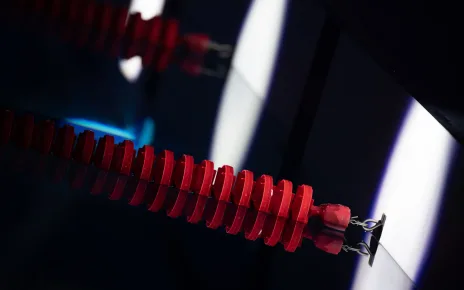UNBELIEVABLE DISCOUNTS AT AMAZON.COM ||
Courtesy: Dominique Hérailh
The French Swimming Federation has released detailed statistics on all swimming finals at the Paris Olympics, and in this article, we’ll use them to convert Leon Marchand’s long course times into short course meters.
Time converters already exist, but as we know, they can produce varied results, especially in events where underwaters are king (short course backstroke, for example) or for swimmers who excel off the walls.
In the case of Leon Marchand, who is arguably the world’s best underwater kicker right now, time conversions clearly don’t work properly. The most striking example is the conversion of the 400 IM from SCY to LCM: 3:28.82 in SCY corresponds to 3:58.19 in LCM, 4.31 seconds under his world record. Going the opposite way, his 4:02.50 long course PB converts to 3:32.70 in yards, almost four seconds shy of his U.S. Open Record.
Although the performances of Marchand are well known in LCM, they are almost non-existent in SCM, though that figures to change this fall with Marchand aiming to race the three World Cup stops and ultimately the SC World Championships.
The potential of Marchand in short course meters will be a wildly debated topic prior to his appearance at these four meets, and we’ll try to nail down what type of performances we can expect—if he’s at his best.
Methodology for converting LCM to SCM:
The time data collected in Paris will be used:
- Reaction, Start 15m,
- Approach to the wall for each turn.
- Turns (time taken at 15 meters)
- Swimming Phases 25, 45, 75, 95 for every hundred meters.
For example, in the 200 breast, we can group these stats in the following table by supplementing it with speeds in m/s on all segments of the race.
| LCM | Distance | Time | Speed |
| Start | 15 | 5.95 | 2.52 |
| 15/25 | 10 | 6.57 | 1.522 |
| 25/45 | 20 | 12.83 | 1.559 |
| Approach (wall) | 5 | 3.07 | 1.629 |
| Turn 1 | 15 | 9.17 | 1.636 |
| 65/75 | 10 | 6.54 | 1.529 |
| 75/95 | 20 | 13.40 | 1.493 |
| Approach (wall) | 5 | 3.06 | 1.634 |
| Turn 2 | 15 | 9.10 | 1.648 |
| 115/125 | 10 | 6.66 | 1.502 |
| 125/145 | 20 | 13.57 | 1.474 |
| Approach (wall) | 5 | 3.20 | 1.563 |
| Turn 3 | 15 | 9.24 | 1.623 |
| 165/175 | 10 | 6.70 | 1.493 |
| 175/195 | 20 | 13.63 | 1.467 |
| Final | 5 | 3.16 | 1.582 |
| 200 | 125.85 | 1.589 |
With it being the easiest to convert, we’ll start with the 200 breaststroke.
Some data points are the same between the table above and the conversion table, those being the start and final values.
Others must be converted taking into account the following points :
- The time of the first length of SCM will be deducted from the measured speed between 15 and 25 m, and so on for the other lengths.
- For turns, we will consider that the time of the first in LCM will be reproduced twice in SCM, the second three times and the last two times. This is unfortunately not based on a measured observation but on an arbitrary decision.
As in most problems to be solved, some data are known (those of Paris), others are unknown. Among the latter, we can mention, without being exhaustive :
- → The OTW (“Over The Water”) difference in swimming speed between a 65-stroke LCM race and a 35-stroke SCY race.
- The influence of repeated turns in short course on the speed of the underwaters.
- Another unknown value, although more marginal, concerns the impact of fatigue on performance between a run of 182.88 meters (SCY) and a run of 200 meters (SCM)
Fortunately, the uncertainty resulting from these unknown values can be reduced significantly. Once the conversion is done in SCM, it will be enough to make another conversion in SCY, where the performances of Marchand are well known. The percentage difference between the result converted in SCY and the records of Marchand’s NCAA records will correct the first two unknowns (difference in swimming speed OTW between LCM and SCM as well as the effect of repetition of turns on their speeds).
Finally, to correct the third unknown we will take, by convention, the ratio between the distances SCY and SCM (182.88/200). This percentage will reduce the previously calculated variance coefficient.
200 Breast
Note that in this event, it is not the time at 15 meters that was taken for the start but the time of the actual length of the underwater since it exceeds 15 meters.
| SCM | Distance | Time | Speed | SCY | Distance | Time | Speed |
| Start | 17.22 | 6.42 | 2.682 | Start | 17.22 | 6.42 | 2.682 |
| OTW 1 | 2.78 | 1.83 | 1.522 | OTW 1 | 0.64 | 0.42 | 1.522 |
| Approach | 5 | 3.07 | 1.629 | Approach 1 | 5 | 3.07 | 1.629 |
| Turn 1 | 15 | 9.17 | 1.636 | Turn 1 | 15 | 9.17 | 1.636 |
| OTW2 | 5 | 3.21 | 1.559 | OTW2 | 2.86 | 1.83 | 1.559 |
| Approach | 5 | 3.07 | 1.629 | Approach 2 | 5 | 3.07 | 1.629 |
| Turn 2 | 15 | 9.17 | 1.636 | Turn 2 | 15 | 9.17 | 1.636 |
| OTW 3 | 5 | 3.27 | 1.529 | OTW 3 | 2.86 | 1.87 | 1.529 |
| Approach | 5 | 3.06 | 1.634 | Approach 3 | 5 | 3.06 | 1.634 |
| Turn 3 | 15 | 9.10 | 1.648 | Turn 3 | 15 | 9.10 | 1.648 |
| OTW 4 | 5 | 3.35 | 1.493 | OTW 4 | 2.86 | 1.92 | 1.493 |
| Approach | 5 | 3.06 | 1.634 | Approach 4 | 5 | 3.06 | 1.634 |
| Turn 4 | 15 | 9.10 | 1.648 | Turn 4 | 15 | 9.10 | 1.648 |
| OTW 5 | 5 | 3.33 | 1.502 | OTW 5 | 2.86 | 1.90 | 1.502 |
| Approach | 5 | 3.06 | 1.634 | Approach 5 | 5 | 3.06 | 1.634 |
| Turn 5 | 15 | 9.10 | 1.648 | Turn 5 | 15 | 9.10 | 1.648 |
| OTW 6 | 5 | 3.33 | 1.502 | OTW 6 | 2.86 | 1.90 | 1.502 |
| Approach | 5 | 3.20 | 1.563 | Approach 6 | 5 | 3.20 | 1.563 |
| Turn 6 | 15 | 9.24 | 1.623 | Turn 6 | 15 | 9.24 | 1.623 |
| OTW 7 | 5 | 3.35 | 1.493 | OTW 7 | 2.86 | 1.92 | 1.493 |
| Approach | 5 | 3.20 | 1.563 | Approach 7 | 5 | 3.20 | 1.563 |
| Turn 7 | 15 | 9.24 | 1.623 | Turn 7 | 15 | 9.24 | 1.623 |
| OTW 8 | 5 | 3.35 | 1.493 | OTW 8 | 2.86 | 1.92 | 1.493 |
| Final | 5 | 3.16 | 1.582 | Final | 5 | 3.16 | 1.582 |
| 200 | 120.43 | 1.661 | 182.88 | 109.10 | 1.676 |
The 1:49.10 conversion to SCY shows a 2.75-second gap from Marchand’s NCAA Record of 1:46.35—or 2.52% (coefficient of -0.0252). As we saw above, the final correction will be to reduce this coefficient in order to integrate the parameter relative to the least effort of a race in SCY vs SCM given the distance difference: -0.0252 x182.88 /200= -0.023
The time converted, assuming Marchand is in the same form as Paris 2024, would be 120.43 x (1- 0.23) = 117.66 or 1:57.66. The world record of Russian Kirill Prigoda, 2:00.16, would be broken by two and a half seconds.
In 2018, when Prigoda broke the SCM world record, he went 2:08.63 in long course meters, nearly three seconds slower than Marchand’s 2:05.85.
This tells us a time in the 1:57.5-1:58.5 range for Marchand would be an accurate prediction, once again assuming peak Olympic form which we can’t count on.
200 Fly
In this event, Marchand has little reference time in SCY. His best time was set in 2022 when he clocked 1:39.57. That year, he swam the LCM 200 fly in 1:53.37. In Paris, he set a new Olympic Record of 1:51.21.
If he theoretically dropped the same amount of time in the yards event, he would go 1:37.41 (taking off 2.16 seconds in two years like he did in LCM).
In my opinion, this value is not entirely accurate for various reasons. One easy example to point out is that Ilya Kharun went 1:37.93 this past season in yards while finishing 1.59 seconds behind Marchand in Paris. Two reference values can therefore be reasonably taken: one corresponding to the minimum possible (1:37.41) and another close to the highest of its current potential (1:36.50).
With the same method, the conversion without correction would result in 1:47.71 for SCM races and 1:37.66 for SCY races.
By applying the correction coefficients according to the principles already stated, we obtain 1:47.46 in average value and 1:46.54 in high value.
Only in this second hypothesis, the world record of Tomoru Honda would be beaten by 0.31 sec.
The time range to consider could be between 1:46.50 and 1:47.50.
200 IM
The 200 IM is not an easy race to convert, as some data collected in the long course event aren’t transferrable into either short course format. This is particularly the case with certain turns (turns with hands, turns with feet) and wall approaches. Data from other races (200 fly, 200 breast, 400 IM) that were consistent with the missing number were used instead.
The best reference time of Marchand on the 200 IM SCY is 1:36.34.
Converting without correction would give 1:49.91 for SCM races and 1:39.48 for SCY races.
By applying the correction coefficients according to the principles already stated, we obtain 1:46.74.
Ryan Lochte’s world record of 1:49.63 would be broken by a whopping 2.89 seconds.
That puts Marchand’s expected time in the 1:46.75 to 1:47.75 range. However, it’s important to remember that Lochte (1:54.00) is still faster than Marchand in long course.
400 IM
The data measured in Paris is not quite the same in the 400 IM as it is for the others, other than the start and turns. The reason things aren’t as exact is because the distance swimmers travel underwater tends to decrease throughout the race. However, this is not necessarily the case for Marchand, so I went in and took the real time and distances of his underwaters.
The intermediate split points are slightly modified from the other events (start, 25, 45 50, 55, 75, 95, 100), and like the 200 IM, adjustments were made for the turns.
The best reference time of Marchand on the 400 IM SCY is 3:28.82.
The conversion without correction would result in 3:53.29 for SCM and 3:31.33 for SCY.
Before the corrections were even made, Daiya Seto’s world record of 3:54.81 would be absolutely shattered. The corrected result would be 3:50.45 for Marhcnad. The world record would be broken by more than four seconds.
Anywhere in the 3:50.5-3:51.5 would be the range we’d see from Marchand if at his best.
Conclusion
Based on his performances in Paris 2024, three SCM world records seem to be within reach of Marchand, while a fourth is possible but far less clear.
| World Record | Average estimate | High estimate | |
| 200 Breast | 2:00.16 | 1:58.50 | 1:57.50 |
| 200 Fly | 1:46.85 | 1:47.50 | 1:46.50 |
| 200 IM | 1:49.63 | 1:47.75 | 1:46.75 |
| 400 IM | 3:54.81 | 3:51.50 | 3:50.50 |
The 200 fly record seems to be the hardest to break. The lack of recent performances from Marchand in short course yards does not allow for fine-tuning estimates.




